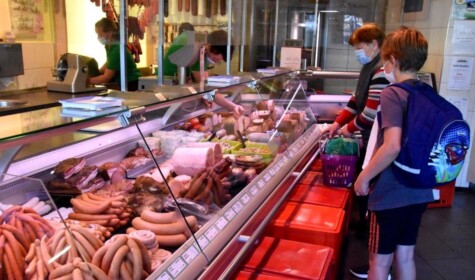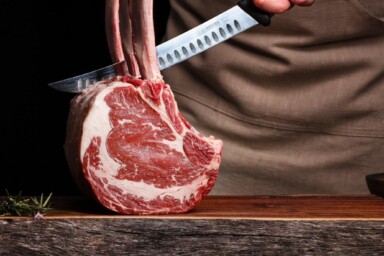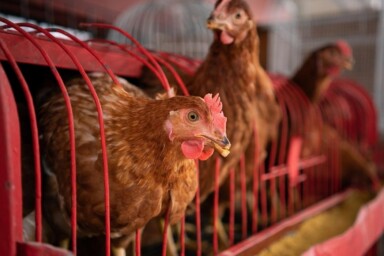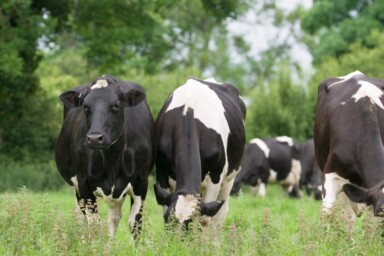Marianne Landzettel has been looking at sustainable agricultural systems and relocalised food production in her native Germany. This is the second part of a detailed examination of a small abattoir and how it works, how they offer improved animal welfare and how the meat that it produces feeds a thriving local economy (see Part I here).
The vet, Jenny Härle, has arrived, and I find her in the cold store where she is inspecting the sides of the five pigs and the piglet, which were slaughtered earlier in the morning. She takes samples which will be checked for trichina at the Memmingen extension of the Bavarian state veterinary department. Everything looks fine and she places a purple stamp on each side of pork – it signifies that a veterinarian has declared the meat fit for human consumption.
The vet
Härle runs a farm veterinary practice together with a colleague. She regularly does the checks at the Legau abattoir, which means that on Fridays and Tuesdays her workday starts before she even has breakfast with her family. Doing these routine controls does not pay well, she says. ‘I am absolutely in favour of small abattoirs, the animals don’t need to be transported far, and the way that they are handled here, it’s really important. That’s why I do this; farmers need this service.’ It would be nice if she could do the checks later, but the samples have to be at the veterinary office by 7.30 am or they won’t be checked that day. Härle walks back into the abattoir where Thomas Kling earlier hooked up the tongue, lung, heart and liver of each pig and placed them on a rail along the wall. She points at one of the lungs: ‘The surface should be smooth, but can you see how rough this looks? And the heart is abnormal too. And here, this dark red bit on this lung, it indicates that the animal had pneumonia as a piglet.’ These findings and the fact that the pigs had docked tails raise concerns, says Härle, who will make a note in the records the state veterinary office keeps on all livestock holders. Should findings of ill health in pigs from this producer become a pattern, there will be an unannounced control visit by the state veterinary service. Would a veterinarian in a large slaughter facility be able to check as thoroughly? Härle gives me a long, raised eyebrow look and says nothing.
Checks on meat is not the only thing she does. ‘Especially in a small facility like this, one also needs to keep an eye on hygiene. Look here, this is the area where the carcasses are sawn in half and the head split. Sometimes the saw or the cleaver touches the floor and then you get grooves in the surface which can be a real issue for hygiene. In a large facility, there is so much wear and tear the floor probably will be resurfaced regularly anyway. In a small facility like this one, I point out things like that.’ And repairs are being carried out; from where we are standing it is easy to see that part of the floor has recently been resurfaced.
Härle is off to have breakfast with her family and we decide to have a break, too, before we meet butchers Klaus Steinhaus and Thomas Kling again, this time at the butchery and shop, opposite the church and right in the centre of Legau.
The shop
When we arrive at the shop at around 9 am, three sales assistants are busy serving a steady stream of customers. The choice of sausages, ham, cold cuts, meat salads, roasts and ribs is huge. An enticing aroma hangs in the air – just as well that there’s a basket with different types of rolls from the local baker for anyone feeling the desire for a freshly prepared, made to order hot or cold meat sandwich.
The shop connects to the butchery, but the entrance is at the back of the building. All of the rooms are tiled from floor to ceiling, steam hangs in the air and there are sausages being cooked in a large vat. Kling has rubbed spices into hams that are now left to cure. Steinhaus grinds meat that will be sold fresh or made into hamburger patties or meatloaves. Work in the butchery starts at 6 am, part-time staff and the trainee do routine jobs before the three full time butchers return from the abattoir and join them. ‘It’s been five years since we last had an apprentice,’ says Steinhaus. In Germany, any apprentice will attend a trade school for usually one day a week, while learning in situ in the abattoir and on the shop floor for the rest of the time. The nearest trade school has just four apprentices who want to become butchers. ‘When I was an apprentice, [there] were 42 in my class; today, only half of them still work in the profession,’ says Kling. ‘Being a butcher has such a negative image: dirty, badly paid and you’ve got to get up early.’ The latter is true, says Kling, ‘but you finish work early too, particularly in summer – that’s brilliant!’ How did he decide to become a butcher? ‘My grandpa was a butcher, my mum worked in a restaurant next to a butcher’s. It was kind of an obvious choice,’ says Kling, who took his butcher’s exam but does not want to study to become a ‘master’. For Steinhaus, it was a career choice he made after a work experience that he had to do as part of the school curriculum. ‘I was 14 and ended up working at a butcher’s. I really liked it and there was no other profession I was particularly keen on, so I chose butchery for my apprenticeship.’
Together, Steinhaus and Kling take all necessary decisions for the business. ‘How many animals we slaughter in a week depends on the time of year,’ they explain. In summer, business is better because of all the barbecues, grill parties, small festivals and events. Usually, these will include a large tent where beer and food are being served; spit roast suckling pig is a particular favourite. The abattoir and the shop were profitable until the pandemic struck: customers bought more meat, but without event catering and party service, overall sales went down by 20%. ‘Now we have parties with 30 or 40 people again, but not events with 300 or 400 guests,’ says Steinhaus. ‘We have a turnover of about a million euros, normally €80,000 comes from big catering jobs. Last year we ended up with a loss of €12,000.’
Another income source is contract slaughter and butchery – both the farmers we met in the morning, will collect the meat from their animals and sell it directly. ‘We offer a bespoke service and farmers really value and appreciate that,’ says Steinhaus. The farmers decide whether they want to take whole sides of beef back to their farm or individual vacuum-packed cuts or whether they require a full butchery service, from ground beef to curing and sausages.
The abattoir has EU and organic certifications, but the butchery is not organically certified. Steinhaus would love to go fully organic but fears that for a number of reasons the market isn’t quite ready for it yet, at least not in Legau. ‘Customers don’t want organic meat,’ he says, ‘it is too expensive. And they don’t like the sausages because of the colour. Under organic standards we would not be allowed to use nitrate salt mixes which means sausages will look grey rather than pink, and customers believe that’s a sign of a meat product well over its sell by date – which in this instance is not the case. Another factor are the organic spices we would need for organic sausages, they are very expensive.’
Sourcing and price
Steinhaus and Kling are responsible for buying the animals that the butchery will process for the shop, as well as all ingredients needed. The animals are sourced only from farmers who are members of the farmers’ association. There are some who supply relatively frequently, but others may only have an animal for slaughter every six months or once a year. In such cases Steinhaus or Kling will visit the farm, inspect the animal on offer and only then decide whether to buy or not.
Prices for meat and sausages in the shop are similar to what customers would pay at a supermarket. The difference is the quality, says Steinhaus. Industrially produced sausages have a high profit margin: the meat used will likely be of low quality and include non-meat ‘fillers’ reducing the cost of the ingredients even further. The butchery in Legau is competitive on price because there is little need for storage as the products are freshly made, customers are served by staff, which means the products don’t need the kind of packing required for display in a supermarket cooling cabinet, and transport costs are minimal.
Behind us a timer sounds, one of the sales ladies from the shop wants to know about a special order – we let Kling and Steinhaus get on with their work and take our leave.






